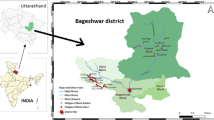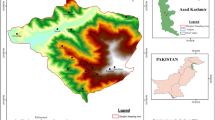Abstract
This chapter depicts considerable information on traditional uses of medicinal plants by Tangsa tribe in Changlang district of Arunachal Pradesh, India. This is the first quantitative ethnobotanical study from the area. Data were collected by interviewing 64 local informants and 07 traditional health practitioners from 11 villages of Changlang district. Medicinal uses of 56 species representing 47 genera and 36 families were documented. Demography of informants; plant habit-groups, parts used, preparation and application methods and ethnomedicinal uses were documented. Collected data were analysed using quantitative tools like Fidelity Level (FL), Use Value (UV), Informant Consensus Factor (ICF) and Relative Frequency Citation (RFC). Clerodendrum glandulosum, Curcuma longa, Mikania micrantha, Psidium guajava and Zingiber officinale were recognised as most popular medicinal plants. Recorded ailments were classified into 11 disease categories based on ICF values. The study reveals the preservation of knowledge on folk medicine by Tangsas in their folk songs and through oral transfer to their descendants. Quantitative evaluation shows the high impact of traditional knowledge of Tangsa tribe. However, medium to low values of some of the data like FL (<50%), UV (<0.5), and RFC (<0.5) in certain species having claims of curing more than two or three diseases requires further scrutiny through phytochemical characterization before promoting their wider uses.
Access this chapter
Tax calculation will be finalised at checkout
Purchases are for personal use only
Similar content being viewed by others
References
Anonymous (2001) Total population, population of scheduled castes and scheduled tribes and their proportions to the total population. Office of the Registrar General and Census Commissioner. New Delhi, Office of the Registrar General and Census Commissioner
Anonymous (2004) The National Tribal Policy (draft). Ministry of Tribal Affairs. Govt. of India, New Delhi, India. Available in: http://tribal.nic.in/finalContent.pdf. Accessed 20 Sept 2018
Anonymous (2014a) The National Tribal Policy (draft). Ministry of Tribal Affairs. Govt. of India, New Delhi, India. Available in: http://tribal.nic.in/finalContent.pdf. Accessed 20 Sept 2020
Anonymous (2014b) Census of India 2011, Arunachal Pradesh: District Census Handbook Changlang [Series 13; Part XIIA]. Directorate of Census Operations, Arunachal Pradesh
Basu S (2000) Dimensions of tribal health in India. Health Popul Perspect Issues 23:61–70
Barkataki-Ruscheweyh M (2013) Performing Identity: the transformation of a Tangsa Festival. Asian Ethnol 72(2):241–258
Barkataki-Ruscheweyh M (2017) Dancing to the state: ethnic compulsions of the Tangsa in Assam. Oxford University Press, New Delhi
Bodding PO (1925–1940) Studies in Santal Medicine and connected folklore. J Asiat Soc Bengal (reprint: 1986)
Bora C (2001) Ethnobotany of Lower Subansiri District (Nishi Tribe) of Arunachal Pradesh, India. Ph.D. Thesis, Gauhati University, Guwahati
Bridson D, Forman L (eds) (1998) The Herbarium handbook, 3rd edn. Royal Botanic Gardens, Kew, UK
Chauhan AS, Singh KP, Singh DK (1996) A contribution to the Flora of Namdapha Arunachal Pradesh. In: Hajra PK (ed) Botanical Survey of India, Kolkata
Chowdhery HJ, Giri GS, Pramanik A (eds) (2009) Materials for the Flora of Arunachal Pradesh, vol III. Botanical Survey of India, Calcutta
Das AP, Ghosh C, Sarkar A, Biswas R (2007) Ethnobotanical studies in India with Notes on Terai-Duars and Hills of Darjiling and Sikkim. NBU J Plant Sci 1:67–83
De JN (1968) Ethnobotany—a newer science in India. Soc Cult 34:326–328
Debbarma M, Pala NA, Kumar M, Bussmann RW (2017) Traditional knowledge of medicinal plants in tribes of Tripura in Northeast, India. Afr J Tradit Complement Altern Med 14(4):156–168
FSI (2011) India state of forest report: forest and tree resources in states and Union Territories. Forest Survey of India, Dehra Dun, pp 97–101
Gangwar AK, Ramakrishnan PS (1990) Ethnobiological notes on some tribes of Arunachal Pradesh, Northeastern India. Econ Botany 44(1):94–105
Giri GS, Pramanik A, Chowdhery HJ (eds) (2008) Materials for the Flora of Arunachal Pradesh, vol II. Botanical Survey of India, Kolkata
Goswami P, Soki D, Jaishi A, Das M, Sarma HM (2009) Traditional healthcare practices among the Tagin tribe of Arunachal Pradesh. Indian J Trad Knowl 8(1):127–130
Grierson AJC, Long DG (eds) (1983, 1984, 1987) Flora of Bhutan, vol 1 parts 1–3, Royal Botanic Garden, Edinburgh
Grierson AJC, Long DG (eds) (1991, 1999, 2001) Flora of Bhutan, vol 2, Pts.1, 2 & 3. Royal Botanic Garden, Edinburgh
Hajra PK, Verma DM, Giri GS (eds) (1996) Materials for the Flora of Arunachal Pradesh, vol I. Botanical Survey of India, Calcutta
Hooker JD (1872–1897) The flora of British India, 7 Vols, L. Reeve & Co. Ltd., Ashford, Kent. London
Jain SK (1963) Studies in Indian ethno-botany: wild plant foods of the tribals of Bastar. Proc Nation Inst Sci India 30B(2):56–80
Jugli S, Chakravorty J, Meyer‑Rochow V (2019) Zootherapeutic uses of animals and their parts: an important element of the traditional knowledge of the Tangsa and Wancho of eastern Arunachal Pradesh, North‑East India. Environ Dev Sustain. https://doi.org/10.1007/s10668-019-00404-6
Kala CP (2005) Ethnomedicinal botany of the Apatani in the Eastern Himalayan region of India. J Ethnobiol Ethnomed 1(1):1–8
Kirtikar RB, Basu BD (1935) Indian medicinal plants, vol I–IV. Lalit Mohan Basu, Allahabad
Lungphi P, Singh AV, Das AP (2019) ‘Phalap-Khah’—the bitter tea of Tangsa community in the Changlang district of Arunachal Pradesh, India. Pleione 13(1):33–40. https://doi.org/10.26679/Pleione.13.1.2019.033-040
Lungphi P, Wangpan T, Tangjang S (2018) Wild edible plants and their additional uses by the Tangsa community living in the Changlang district of Arunachal Pradesh, India. Pleione 12(2):151–164. https://doi.org/10.26679/Pleione.12.2.2018.151-164
Majumdar GP (1938) Some aspects of Indian Culture—from plant perspective. Calcutta
Mao AA (2013) Ethnobotany of rhododendrons in North Eastern India. Ethnobotany 25:124–128
Mao AA, Hynniewta T, Sanjappa M (2009) Plant wealth of Northeast India with reference to ethnobotany. Indian J Trad Knowl. 8:96–103
Mao AA, Roy DK (2016) Ethnobotanical studies in North East India: a review. In: Jain AK (ed) Indian ethnobotany: emergency trends. Scientific Publisher, Jodhpur. [Researchgate: 286869748]
Morey S (2011) Tangsa agreement markers. In: Hyslop G, Morey S, Post M (eds) North East Indian Linguistics II. Cambridge University Press India, pp 76–103
Morey S (2017) The prehistory of Tangsa as recorded in traditional songs and stories. (a presentation). Lecture delivered at La Trobe University, Australia on 9th February 2017 (text version in press)
Morey S (2020) Loekyam Cholim—history of the Tangsa. The language archive, max planck institute for psycholinguistics [Consulted, August 2020]
Murtem G, Chaudhry P (2016) An ethnobotanical study of medicinal plants used by the tribes in upper Subansiri district of Arunachal Pradesh, India. Am J Ethnomed 3(3):35–49
Noltie HJ (ed) (1994, 2000). Flora of Bhutan, vol. 3 parts 1 & 2, Royal Botanic Garden, Edinburgh
Pal DC (2000) Ethnobotany in India. In: Singh NP, Singh DK, Hajra PK, Sharma BD (eds) Flora of India, introductory volume, part II. Bishen Singh Mahendra Pal Singh, Dehradun, pp 303–317
Pal DC (2002) Ethnobotany in India. In: Flora of India. Introductory Vol. Part II: 303–320
Pal DC (2007) Ethnobotany. In: Das AP, Pandey AK (eds) Advances in ethnobotany. Bishen Singh Mahendra Pal Singh, Dehradun
Patricia M, Isabel CFRF, Ana MC, Virginia F-R, Cortes S-M, Montaña C, Ramón M, Javier T (2013) Wild edible fruits as a potential source of phytochemicals with capacity to inhibit lipid peroxidation. Eur J Lipid Sci Technol 115:176–185
Rakotonirina VS, Bum EN, Rakotonirina A, Bopelet M (2001) Sedative properties of the decoction of the rhizome of Cyperus articulates. Fitoterapia 72:22–29
Rodgers WA, Panwar HS (1988) Planning a wildlife protected area network in India. 2 vols. Wildlife Institute of India, Dehra Dun
Rinyo R, Taram M, Hui PK, Tag H (2018) Ethnobotanical resources and traditional skills prevalent among the Tagin community of Arunachal Pradesh, India. Pleione 12(2):265–274
Sarkar A, Das AP (2011) Plants used in contact therapy by Mech tribe in Duars of West Bengal, India. In: Ghosh C, Das AP (eds) Recent studies in biodiversity and traditional knowledge in India. Sarat Book House, Kolkata, pp 311–314
Sarmah R, Arunachalam A (2011) Contribution of Non-Timber Forest Products (NTFPS) to livelihood economy of the people living in forest fringes in Changlang district of Arunachal Pradesh, India. Indian J Fundam Appl Life Sci 1(2):157–169
Sen P, Kujur S, Bag S (2019) Medicinal plants : traditional knowledge and healthcare practices of rural communities in North Eastern States of India. Caritas India, New Delhi
Simai C (2008) A profile of Tikhak Tangsa of Arunachal Pradesh. Authorspress, Pittsbirg, New Delhi
Srivastava RC, Nyishi community (2010) Traditional knowledge of Nyishi (Daffla) tribe of Arunachal Prades. Indian J Tradit Knowl 9(1):26–37
Tag H, Das AK (2004) Ethnobotanical notes on the Hill Miri tribe of Arunachal Pradesh. Indian J Tradit Knowl 3(1):80–85
Tag H, Das AK, Kalita P (2005) Plants used by Hill Miri tribe of Arunachal Pradesh in ethnofisheries. Indian J Tradit Knowl 4(1):57–64
Umair M, Altaf M, Abbasi AM (2017) An ethnobotanical survey of indigenous medicinal plants in Hafizabad district, Punjab-Pakistan. PLoS ONE 12(6):e0177912. https://doi.org/10.1371/journal.pone.0177912
Umair M, Altaf M, Bussmann RW, Abbasi AM (2019) Ethnomedicinal uses of the local flora in Chenab riverine area, Punjab province Pakistan. J Ethnobiol Ethnomed 15(7):31. https://doi.org/10.1186/s13002-019-0285-4
United Nations (2004) The Concept of Indigenous Peoples. New York, United Nations. Available: http://www.un.org/esa/socdev/unpfii/documents/PFII%202004%20WS.1%203%20Definition.doc. Accessed 12 Feb 2020
World Bank (2005) Indigenous Peoples. OP 4.10. Washington (D.C.), World Bank. Available: http://wbln0018.worldbank.org/Institutional/Manuals/OpManual.nsf/tocall/0F7D6F3F04DD70398525672C007D08ED? Open Document. Accessed 26 Feb 2019
Author information
Authors and Affiliations
Corresponding author
Editor information
Editors and Affiliations
Rights and permissions
Copyright information
© 2022 The Author(s), under exclusive license to Springer Nature Switzerland AG
About this chapter
Cite this chapter
Lungphi, P., Das, A.P., Ayam, V. (2022). Ethnomedicinal Knowledge of Tangsa Community from Patkai Hills Region of Changlang District in Arunachal Pradesh, India. In: Rashid, A.Z.M.M., Khan, N.A., Hossain, M. (eds) Non-Wood Forest Products of Asia. World Forests, vol 25. Springer, Cham. https://doi.org/10.1007/978-3-030-99313-9_4
Download citation
DOI: https://doi.org/10.1007/978-3-030-99313-9_4
Published:
Publisher Name: Springer, Cham
Print ISBN: 978-3-030-99312-2
Online ISBN: 978-3-030-99313-9
eBook Packages: Biomedical and Life SciencesBiomedical and Life Sciences (R0)




